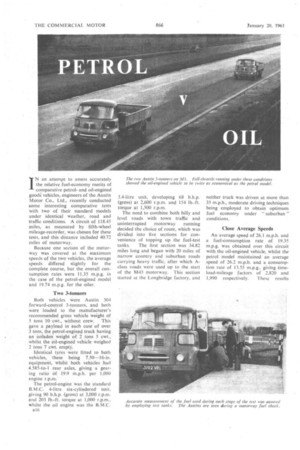I N an attempt to assess accurately the relative fuel-economy merits
Page 50

Page 51

If you've noticed an error in this article please click here to report it so we can fix it.
of comparative petroland oil-engined good vehicles, engineers of the Austin Motor Co., Ltd., recently conducted some interesting comparative tests with two of their standard models under identical weather, road and traffic conditions. A circuit of 118.45 miles, as measured by fifth-wheel mileage-recorder, was chosen for these tests, and this distance included 40.72 miles of motorway.
Because one section of the motorway was covered at the maximum speeds of the two vehicles, the average speeds differed slightly for the complete Course, but the overall consumption rates were 11.35 m.p.g. in the case of the petrol-engined model and 19.74 m.p.g. for the oiler.
Two 3-tonners
Both vehicles were Austin 304 forward-control 3-tanners, and both were loaded to the manufacturer's recommended gross vehicle weight of
5 tons '10cwt., without crew. This gave a payload in each case of over 3 tans, the petrol-engined truck having an Unladen weight of 2 tons 5 cwt., whilst the oil-engined vehicle weighed . 2 tons 7.cwt. empty. .
identical -tyres Were . fitted to both vehicles, , .these being . 7.50-16-in. equipment, whilst both vehicles had 4.585-to-1 rear axles,. .giving a gearing ratio . Of • 19.9 m.p.h. per 1,000 engine r.p.m.
The petrol-engine was the standard B.M.C. 4-litre six-cylindered unit, giving 90 b.h.p. (gross) at 3,000 r.p.m. and 203 lb.-ft. torque at 1,000 r.p.m., whilst the oil engine was the B.M.C.
B16
3.4-litre unit, developing 68 b.h.p. (gross) at 2,600 r.p.m. and 154 lb.-ft. torque at 1,500 r.p.m.
The need to combine both hilly and level roads with town traffic and uninterrupted motorway running decided the choice of route, which was divided into five sections for convenience of topping up the fuel-test tanks. The first section was 34.82 miles long and began with 20 miles of narrow country and suburban roads carrying heavy traffic, after which Aclass roads were used up to the start of the M45 motorway. This section started at the Longbridge factory, and neither truck was driven at more than 35 m.p.h., moderate driving techniques being employed to obtain optimum fuel economy under " suburban " conditions.
Close Average Speeds
An average speed of 26.1 m.p.h. and a fuel-consumption rate of 1935 m.p.g. was obtained over this circuit with the oil-engined vehicle, whilst the petrol model maintained an average speed of 26.2 m.p.h. and a consumption rate of 13.55 m.p.g., giving timeload-mileage factors of 2,820 and 1,990 respectively. These results
Strictly Controlled Comparative Tests Conducted by Austin Engineers on Petroland Oil-engined 3-ton Lorries Reveal Relative Fuel-consumption Rates Under Varying Conditions.
showed the petrol engine to be 33.5 per cent, heavier on fuel than the oil engine.
The second section of the course was 23.12 miles long, measured from the northern end of M45 to the M intersection with A508. Both vehicles were driven at full throttle continuously, the oil-engined lorry-the maximum speed of which was 49 m.p.h. -averaging 44,1 m.p.h., whilst the petrol-engined vehicle, because its maximum speed was 60 m.p.h., was able to average 545 m.p.h. The resulting consumption rates for the two vehicles were 20.8 m.p.g. and 10.0 m.p.g. respectively, giving timeload-mileage factors of 5,130 and 3,050. The doubled fuel consumption of the petrol-engined model compared with that of the oiler is interesting.
Market-day Traffic
A distance of 8.84 miles comprised the third section, this being from the Ml-A508 junction into the centre of Northampton, market-day traffic introducing enforced stop-start running, whence the course continued to the A45-M1 intersection.
Over this section the average speeds were almost identical-24.7 m.p.h. for the oiler and 24.6 m.p.h. for the petrol model-and the fuel-consumption rates again showed a considerable difference-12.95 m.p.g. as against 8,56 m.p.g. During this part of the test the oiler's speed was kept down to 40 m.p.h., whilst the petrol vehicle was driven at up to 45 m.p.h., and the comparative differences in the consumption rates are almost identical to those recorded during the first section of the test.
Ml, from its junction with A45, and the full length of M45-a distance of 17.6 miles-formed the fourth section. and both vehicles covered this stretch of motorway at a steady cruising speed of 30 m.p.h., wherever possible, despite which the average speed in both cases was 30.4 m.p.h., presumably because of top-speed discrepancies downhill when endeavouring to compensate accurately for reduced uphill speeds.
Consumption Halved
In this case again the petrol-engined Austin consumed almost twice as much fuel as the oiler, the respective consumption rates being 16.2 m.p.g. and 31.45 m.p.g.
The final section of the course was 34.07 miles long and extended from the northern end of M45, through
Meriden, Solihull and Wythall, to the Austin works at Longbridge. A brisk driving technique was used, with maximum speeds of over 45 m.p.h., and heavy traffic Was encountered over much of the route. The oilengined 3-tonner averaged 26.7 m.p.h. and 18.4 m.p.g., whilst the petrol job averaged 30.6 m.p.h. and 9.75 m.p.g.. again showing the oiler to be twice as economical when driven vigorously through thick traffic as the petrolengined version.
Economic Advantages
Taking the results as five separate results rather than as a whole, it is seen that under three conditions-fullthrottle running, steady 30 m.p.h. driving and hard driving-the fuelconsumption rate of the petrol-engincd 3-tonner was almost exactly twice that of the oiler. Under the two remaining conditions-moderate driving and town running-the petrol-engined vehicle's economy was more favourable, being only 33.5 per cent, heavier than that of the oiler. •




















































































































